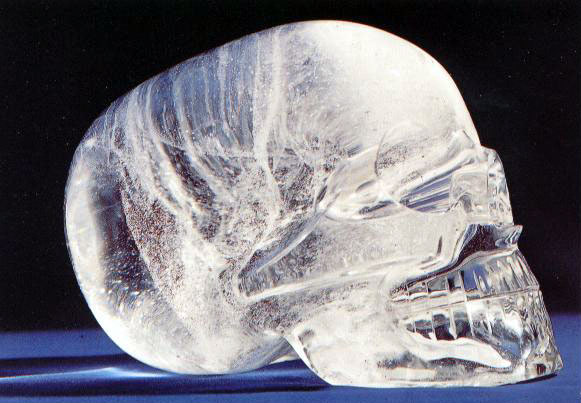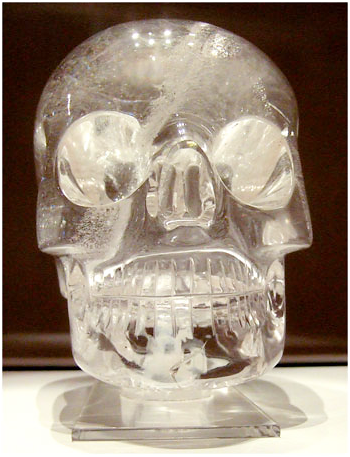

More Crystal Skulls Deemed Fakes By Richard Ingham, AFP
July 9, 2008 -- How about this for the next installment of the Indy franchise: "Indiana Jones and the Dodgy Antiques Dealer"?
Less than three months after the Quai Branly Museum in Paris discovered that a crystalskull once proclaimed as a mystical Aztec masterpiece was a fake, it is now the turn of the British Museum and the Smithsonian Institution to find they were victims of skull-duggery.
Scientists from those two prestigious institutions on Wednesday said their crystal skulls were cut, honed and polished by tools of the industrial age, not by Mesoamerican craftsmen of yore.
"The skulls under consideration are not pre-Columbian. They must surely be regarded as of relatively modern manufacture," they say.
The superstitious deemed them part of a collection of 12 skulls, endowed with healing or mystical powers, that dated back to the ancient culture of Central America.
Reuniting all 12 skulls, together with a putative 13th, would conjure up a massive power that would prevent the Earth from tipping over on December 21 2012, the "doomsday" in the Mayan calendar, according to one fable.
Legend-lovers had a bad day on April 18 when the Quai Branly said it had found grooves and perforations in its 11-centimeter (4.4-inch) -high quartz skull revealing the use of "jewelery burrs and other modern tools."
Doubts had also surfaced about the skulls in London and Washington, with art experts noting they were unusually large and with teeth markings that were exceptionally linear.
Seeking the verdict of science, researchers from those two museums examined the skulls with electron microscopes, looking at tiny scratches and marks left by the carving implements.
These were then compared with the surfaces of a crystal goblet, rock crystal beads and dozens of greenstone jewels known to be of genuine Aztec or Mixtec origin.
The study appears in the Journal of Archaeological Science, published by the Elsevier group.
The skull in the British Museum, purchased in 1897, is made of transparent rock crystal and is 15 centimeters (six inches) high. The Smithsonian skull, acquired by the museum in 1992, is of white quartz and measures 25.5 cms (10 inches) in height.
The investigators found that rotary wheels gave the British skull its sharp definition, a drill had dug out the nostrils and eyes, and diamond or corondum had been applied with iron or steel tools to smooth its upper surfaces.
As for the U.S. skull, "faint traces" of tool marks remain, but these too are consistent with rotary wheels or grinding pads, the authors say.
No evidence has ever been found that rotary wheels were used to cut stones in Central America before the arrival of Europeans.
The investigators also found a black-and-red deposit in a tiny cavity of the Smithsonian skull. X-ray diffraction showed it to be silicon carbide -- a tough compound that only exists naturally in meteorites but is widespread in modern industrial abrasives.
|
 "Each skull was probably worked not more than a decade before it was first offered for sale."
The skulls became star exhibits in all three museums long before the Indiana Jones movie, "The Kingdom of the Crystal Skull," hit the movie screens this year.
"Each skull was probably worked not more than a decade before it was first offered for sale."
The skulls became star exhibits in all three museums long before the Indiana Jones movie, "The Kingdom of the Crystal Skull," hit the movie screens this year.